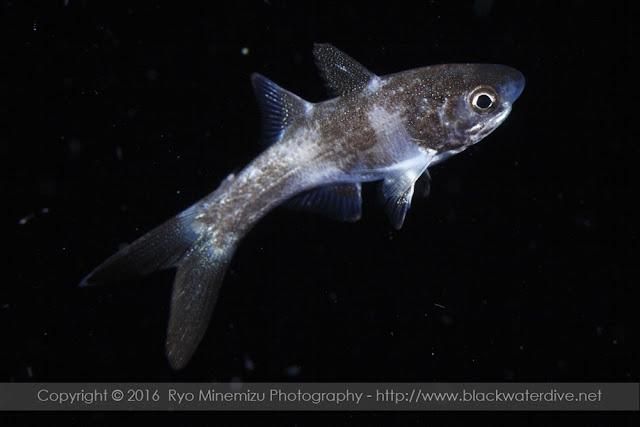This is a Juvenile of
Polydactylus sp. It's a fish of Family
Polynemidae. Polynemidae species is rare fish at Scuba Diving. It inhabits the sandy bottom, sand, mud bottom of the bay. Sometimes entering the brackish water. and It's often observed around the beach. But, probably, they are doing "abortive migration" at Japanese sea. Because, Adult is not a lot in Japan.
 |
| Juvenile of Polydactylus TL:50mm |
 |
| Juvenile of Polydactylus TL:50mm |
Meristic Characters - D Ⅷ-Ⅰ,13; A Ⅲ, 12; P
1 13+6; P
2 Ⅰ, 5; (This picture)
I could not getting the specimen of this species. In Japan so far, Polynemidae is known only 4 species from 2 genera of
Eleutheronema and
Polydactylus. I did think that it's
Polydactylus sexfilis of these four from”Meristic Characters”, but there was a difference in the
number of pectoral fine. Since the measurement of the pectoral fin is such from the image, it might not be accurate. It is very similar to the
Polydactylus sexfilis, but perhaps It's a possibility other than known distribution and species. In recent years, the Polynemidae are known 8 genera 43 species in the world. Of these, have been known 21 species at the
Polydactylus.
Polydactylus sexfilis (Valenciennes, 1831) - (Japanese name: Nanyo-agonashi)
D Ⅷ-Ⅰ,12-13; A Ⅲ, 11-12; P1 15-16+6; P2 Ⅰ, 5;
Related species; (in Japan)
Eleutheronema tetradactylum (Shaw, 1804) - (Japanese name: Minami-konoshiro)
D Ⅷ-Ⅰ,13-15; A Ⅲ, 14-16; P1 17-19+4; P2 Ⅰ, 5;
Polydactylus plebeius (Broussonet, 1782) - (Japanese name: Tubame-konoshiro)
D Ⅷ-Ⅰ,12-13; A Ⅲ, 11-12; P1 15-18+5; P2 Ⅰ, 5;
Polydactylus sextarius (Bloch & Schneider, 1801) - (Japanese name: Kataguro-konoshiro)
D Ⅷ-Ⅰ,12-13; A Ⅲ, 11-13; P1 13-15+6; P2 Ⅰ, 5;
Pectoral filaments is very long and It reaches the anal fins.
 |
| Pectoral filaments 6 |
 |
| Pectoral soft rays does not branch |
REFERENCES:
Motomura, H. 2004. Threadfins of the world. An annotated and illustrated catalogue of polynemid species known to date. Family Polynemidae. FAO Species Catalogue for Fishery Purposes. No. 3. Rome, FAO. 117 p., 151 figs, 6 pls.
Nakabo, T. (ed.), 2013. Fishes of Japan with pictorial keys to the species, third edition. Tokai University Press, Kanagawa, Pp, 2428. (in Japanese).
Fishbase.org
Family Polynemidae - Threadfins
Polydactylus sexfilis, Sixfinger threadfin : fisheries, aquaculture, gamefish, aquarium









